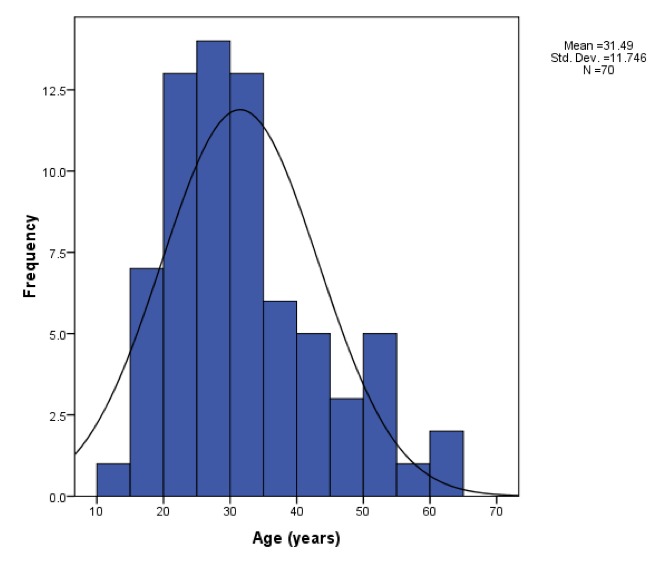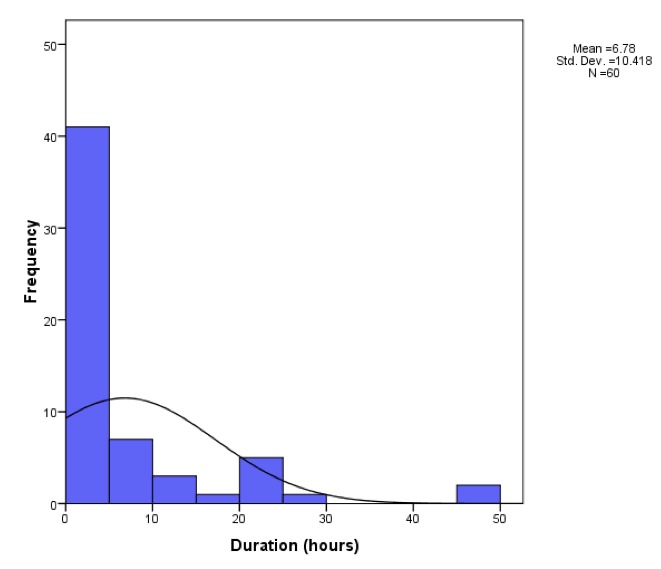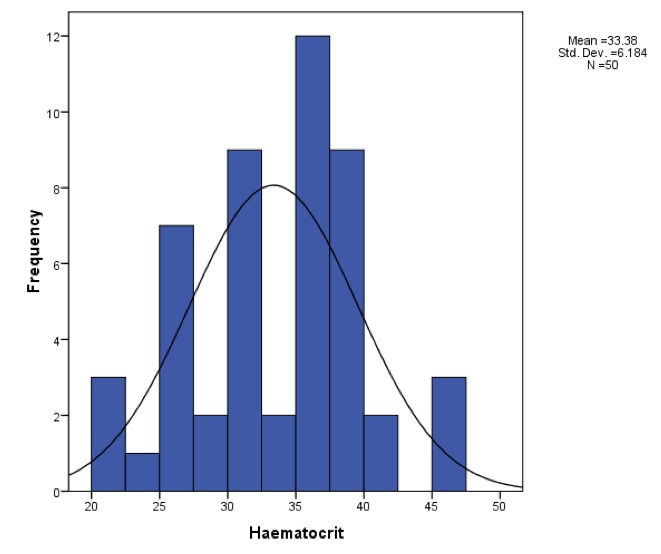Abstract
Background: Chest trauma is a major cause of morbidity and mortality worldwide. Hospital based studies in Nigeria show it predominantly affects the youth in society.
Aim & Objectives: To determine the pattern and management outcomes of patient presenting with chest trauma at the University of Benin Teaching Hospital, Benin City, Nigeria.
Materials and Methods: This is a prospective study of 73 consecutive patients managed for chest injuries between January 2008 and February 2009 at the University of Benin Teaching Hospital, Benin City.
Results: A total of 73 patients were enrolled in the study. The mean age was 31.5years and median age of 29years. About 81% of the patients were 42yrs and below while 10% were more than 50yrs old. About 88% of the patients were males while 12% were females giving a male: female ratio of 1:7 Most (56%) of the patients were single. Motor Vehicular Accidents (MVAs) accounted for 52% while 43%% were due to violence or assaults. Motorcycle accidents accounted for 15% while Cars, Buses, Vans, Trucks accounted for 37%. Penetrating trauma accounted for 43% of which gunshot wounds accounted for 25%, and stab injuries accounted for 13(18%). About 53% were isolated blunt chest injuries whereas 43% were isolated penetrating chest injuries; 4% of the cases sustained both penetrating and blunt injuries. About 27% presented within an hour of injury, while in all, 95% of the patients presented within 24hours of injury. Diaphragmatic injuries were sustained in 6(8%) patients while cardiac injury was observed in one patient.
Conclusion: Chest trauma predominantly affects the youth with high morbidity and mortality in this environment. Public enlightenment with prompt and effective treatment will impact positively on this persistent problem.
Keywords: Chest trauma, High mortality and morbidity, Benin City , Nigeria
Introduction
Trauma is the leading global cause of death, hospitalization and morbidity in the first four decades of life. Chest trauma accounts for 10% of global admissions for trauma but attributes for 25% of 1. The picture in sub-Saharan Africa mirrors the worldwide trend as chest trauma account for most surgical emergencies admissions and death in most series 2,3,4.
Road Traffic Accidents account for up to 70% of all causes of chest trauma in civilian practice.3 However with increased violence and violent crimes in sub-Saharan Africa, the incidence of penetrating trauma is increasing5,6,7.
Chest trauma is a major cause of morbidity and mortality worldwide. Though country wide statistics are ongoing in Nigeria, hospital based studies show it is predominantly a disease of the youth in society3,5,6. The spectrum varies according to socio-economic class. It is second only to head injury as the leading cause of death from trauma. Being a disease affecting the mobile and active groups in the community, the associated high morbidity and mortality are a strain on the economy of most sub-Saharan nations. Hospital based studies continue to show that chest trauma is a major cause of morbidity and mortality in Emergency Care centers3,5,6.
In order to ascertain the incidence, causes and management outcomes of patient presenting with chest trauma at the University of Benin Teaching Hospital, Benin City, we prospectively studied all the chest injured patients managed at this centre over a 2-year period.
Reports
Materials and Methods
This is a prospective study undertaken in the University of Benin Teaching Hospital Benin City – a regional trauma centre in the South-south, Nigeria between January 2008 and February 2009. All the consecutive trauma patients presenting at the center during the period of the study were enrolled in the study. The patients were assigned a serial number and their clinical data entered into a questionnaire designed for that purpose. The data collected included the date and time of injury, the causes and trajectory of injuries and the clinical presentations. The relevant investigations, treatment, outcome and the duration of follow-up were all entered in the questionnaire. The data collected were analyzed for mean, standard deviation and percentages using SPSS 16.
Results
A total of 73 patients were enrolled in the study. The mean age was 32±12years and median age of 29years as shown in Fig. 1. About 81% of the patients were 42yrs and below while 10% were more than 50yrs.
The highest incidence was seen in males comprising 88% of the patients while females accounted for 12%. Most of the patients were single (56%).
About 27% presented within an hour of injury; 75% presented within 6 hours of injury and 95% presented within 24hours as shown in Fig. 2.
The causes of trauma are as shown in Table 1 while the social classes of the patients are shown in Table 2.
The radiological features are shown in Table 3 while Table 4 shows the types of chest injuries sustained. Table 5 show the associated injuries.
The mean Haematocrit at presentation was 33 and Glasgow Coma Score was 14, Revised Trauma Score was 8.1.
Treatment & Outcome: Tube thoracostomy was offered in 37(51%) while 7(9.6%) patients had thoracotomy, and laparotomy was offered in 10(13.7%) patients for associated injuries. Blood was transfused in 18 (25%) patients.
Two(2.7%) patients died in this study. Both of them presented within an hour of injury and both sustained penetrating gunshot wounds with open pneumo-haemothorax and massive blood loss.
Mean duration of hospitalization was 7days.
Conclusions
Chest trauma predominantly affects the youth with high morbidity and mortality in this environment. Public enlightenment with prompt and effective treatment will impact positively on this persistent problem.
Discussion
Chest trauma is a disease of the young as attested to by our findings with a mean age of 31±11years and it affected more young men 64(88%) than females 9 (12%). Males were more affected as described in other as they are more mobile and often involved in long distance journeys in their work 2,5,6,7,8. This is because they are more involved in risky lifestyles including speeding vehicles, violence and falls. The focus of health education towards reducing the incidence of trauma and severity of trauma should be directed towards this group. Being upwardly mobile and literate, public enlightenment programs should easily reach them2,5,6,7,8.
Motor vehicular accidents accounted for most cases (52%) in this study and most (21%) were commercial vehicles plying intercity routes. Motorcycle accidents were also important and accounted for (15%) of the chest injuries. Isolated blunt or penetrating wounds were more common continuing for 69(94.5%) of cases in this study while mixed penetrating and blunt injuries were uncommon as they accounted for 4(5.5%) cases – a feature also reported elsewhere by other workers4,5,6.
Most of the patients (95%) presented within six hours of injury while 26% of the patients presented within an hour of chest injury. This is may have been because of the severity of chest injuries as 21(29%) patients presented with severe life threatening chest injuries. The absence of an organized ambulance service with first responders accounted for the low number of patients presenting within an hour of injury. Early presentation after a chest injury coupled with prompt and effective management at a trauma centre is the key to a good outcome 7. Provision of a sustainable ambulance service with trained staff should be the focus of our policy makers and health administrators in order to improve the outcome and reduce the morbidity and mortality associated with chest injuries 7,8.
Majority (49%) of injuries were confined to the chest wall and pleural. Visceral injuries necessitating surgical intervention were observed in 23% of the chest injured patients. This compares with studies done in Ethopia and Tanzania 7,8. This finding may depict the low number of severe injuries in these patients and may also not be unconnected with the poor retrieval system such that fatally injured patients may have died without reaching the hospital. Even though injuries to the chest appeared to alarm patients and their helpers such that they were routinely transferred to seek medical care, yet many may not have survived since retrieval systems with properly organized ambulance services were not available. Thus though patients were routinely rushed into the hospital on account of injuries to the chest, yet only those who were strong enough reached the hospital early enough for resuscitation. In order to capture all the patients involved in chest injuries as some of them would have expired at the scene of the accidents, there is the need to include autopsy reports of all the patients who died from chest injuries. This is a limitation of this study. Thoracostomy was all that was needed to manage 51% of the patients with supplementary analgesics, antibiotics and chest physiotherapy – feature reported in other studies 9.
Routine chest x-ray was enough assessment for most cases. CT scan was only done for those with suspected great vessel and tracheobronchial injuries as well as intra-abdominal visceral injury who were stable enough for the procedure. There was no occult pneumothorax in the series as erect or lateral decubitus chest x-ray revealed all the cases of pleural collection.
Associated non thoracic organ injury was seen in 8 (11%) of patients and is comparable with other studies 2,5,6,7,8
Figure 1:

Age distribution of the patients with chest injuries
Table 1: Mechanism of Injury
| Type of Injury | Number | Percentage | |
| MVA | Truck/Lorry/Vans/Bus | 15 | 20.5 |
| Car | 12 | 16.4 | |
| Motorbike | 11 | 15.1 | |
| Gun Shot Wound | 18 | 24.7 | |
| Stab wound | 13 | 17.8 | |
| Fall | 1 | 1.4 | |
| Blow | 3 | 4.1 | |
| Total | 73 | 100 | |
Table 2: Social classes of the patients
| Educational Level | Number | Percentage |
| None | 1 | 1.4 |
| Primary | 12 | 16.4 |
| Secondary | 24 | 32.9 |
| Tertiary | 16 | 21.9 |
| Undisclosed | 20 | 27.4 |
| Total | 73 | 100 |
Table 3: Radiological findings in patients
| Chest X-ray CT | Number | Percentage |
| Normal | 22 | 28.0 |
| Pleural Fluid Collection | 42 | 57.5 |
| Rib Fractures | 7 | 9.0 |
| Lung Contusion | 6 | 7.7 |
| Mediastinal Injury | 2 | 2.6 |
| Retroperitoneal | 1 | 1.3 |
| Total | 78 | 100 |
Table 4: Types of thoracic injuries
| Injuries | Number | % |
| Chest Wall bruises/haematoma | 36 | 49.3 |
| Haemothorax | 36 | 49.3 |
| Chest Wall Laceration/avulsions | 34 | 46.6 |
| Lung Contusion | 20 | 27.4 |
| Rib Fracture | 16 | 21.9 |
| Closed Pneumothorax | 12 | 16.4 |
| Open Pneumothorax | 9 | 12.3 |
| Surgical Emphysema | 7 | 9.6 |
| Flail Chest | 4 | 5.5 |
| Diaphragm rupture | 6 | 8.2 |
Table 5: Associated injuries
| Injury | Number | Percentage |
| Clavicle | 4 | 5.5 |
| Bruises to the Face and Skull | 4 | 5.5 |
| Spleen | 4 | 5.5 |
| Stomach | 3 | 4.1 |
| Humerus | 3 | 4.1 |
| Neck laceration | 2 | 2.7 |
| Traumatic Brain Injury | 2 | 2.7 |
| Cervical Spine | 3 | 4.1 |
| Liver | 2 | 2.7 |
| Femur | 1 | 1.4 |
| Kidney | 1 | 1.4 |
Figure 2:

Duration between chest injury and presentation
Figure 3:

Haematocrit distribution of the patients at presentation
Footnotes
Competing Interests: The authors have declared that no competing interests exist.
Grant support: None
References
- 1.Miller DL, Mansour KA. Blunt traumatic chest injuries. Thoracic Surgery Clinics. 2007;17:57–61. doi: 10.1016/j.thorsurg.2007.03.017. [DOI] [PubMed] [Google Scholar]
- 2.Lema MK, Chalya PL, Mabula JB, Mahalu W. Pattern and Outcome of Chest Injuries at Bugando Medical Centre in Northwestern Tanzania. Journal of Cardiothoracic Surgery. 2011;6:7–7. doi: 10.1186/1749-8090-6-7. [DOI] [PMC free article] [PubMed] [Google Scholar]
- 3.Ofoegbu RO, Ohanaka CE, Okugbo SU, Anyanhun G. Functional Concepts in the Management of Simple Chest Injuries. Nigeria Journal of Surgical Sciences. 2002;12:56–64. [Google Scholar]
- 4.Frimpong-Boateng K, Amoati ABG. Chest injuries in Ghana. West Afr J Med. 2000,;19:175–175. [Google Scholar]
- 5.Ali N, Gali BM. Patter and management of chest injuries in Maiduguri, Nigeria. Annals of African Medicine. 2004;3:181–184. [Google Scholar]
- 6.Grover LG, Harman PK, Robinson PD, Trinkle JK. Management of penetrating lung injury in 184 Chest injuries in Maiduguri, Nigeria.Civilian practice. J Thorac Cardiovasc Surg. 1995. pp. 184–184. [PubMed]
- 7.Massaga FA, Mchembe M. The Pattern and Management of Chest trauma at Muhimbili National Hospital, Dar es Salaam. East and Central African Journal of Surgery. 2010;15:124–29. [Google Scholar]
- 8.Adem AA, Ilagoa R, Mekonen E. Chest injuries in Tikur Anbessa Hospital, Addis Ababa, Ethiopia: 3-year experience. East and Central African Journal of Surgery. 2009;6:11–14. [Google Scholar]
- 9.Chalkiadakis G, Drositis J, Kafetzakis A, Kassotakis G, Mihalakis J, Sanidas E, Tsiftsis D Valassiadou. Management of simple thoracic Injuries at a level I trauma centre: can primary health care system take over?Injury. 2000;31:669–675. doi: 10.1016/s0020-1383(00)00084-x. [DOI] [PubMed] [Google Scholar]
- 10.Bender JS, Freedland M, Levison MA, Wilson RF. The management of flail chest injury: factors affecting outcome. J Trauma. 1990;30:1460–1462. doi: 10.1097/00005373-199012000-00004. [DOI] [PubMed] [Google Scholar]


